What Do The Star Trek Uniform Colors Mean & Why Are They So Important?
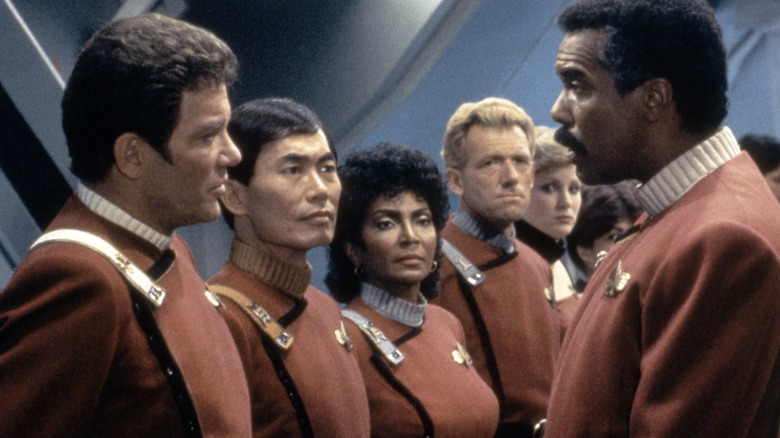
"Star Trek" is definitely a technicolor wonderland of a show. That sense of eye-catching brilliance trickles down from the background scenery to the props used by each cast member, all the way to the uniforms the show's central crew wears as a part of their duties.
It's easy to notice that the crew of the Starship Enterprise wear tunics in varying shades. Those colors are quite important — they denote which job class each crew member belongs to. Those classes were devised by series creator Gene Roddenberry and costume designer William Ware Theiss, and are intended to resemble the classifications used by the United States Military on noise-heavy aircraft carriers.
Sometimes there are differences allowed for dress uniforms; the command staff, for instance, will wear green uniforms during formal occasions. And these rules aren't hard and fast ones; across the whole universe of "Star Trek" series, films, and other ephemera, the colors various officers wear on the show and the meanings behind them change depending on when the scene takes place in the show's general timeline. But these are the color codes that most often denote each character's job on the ship, and the ones used during the original "Star Trek" series to explain who is who and what they do.

The term 'red shirt' gained a negative connotation
Even if you're not a "Star Trek" fan, you've probably heard jokes about how often red-shirted officers are introduced to the show, only for them to quickly die during away missions. For a period of time, the term "red shirt" became a dirty word in the "Star Trek" world; it's gone on to take on a larger cultural significance, indicating that a person is a disposable background element easy to get rid of. And yet many of the show's red-toting characters are the franchise's longest-lasting individuals. The class encompasses the engineering, security, and communication staff positions on the Enterprise. Lt. Nyota Uhura (Nichelle Nichols) and Montgomery "Scotty" Scott (James Doohan) are among the most prominent crew members who wear scarlet hues. To wear red on the bridge is definitely a high honor.
Are 'red shirts' more doomed than their counterparts? Mathematician James Grime weighed in on the subject during a talk at New York's Museum of Mathematics in 2017. A simple statistical calculation revealed that 10% of the show's red-shirted denizens die during the original show's run — compared to 18 percent of golden-shirted characters. "There is some truth in the old 'Star Trek' myth if you look at security officers ... 20 percent of security officers died. So I think the moral of the story is, if you're on the starship Enterprise and you want to survive, be a scientist," he said.
Ironically, crimson red was eventually used to denote a position of authority on the ship; the uniforms that debuted in "Star Trek II: The Wrath of Khan" place the crew in scarlet togs, with no color divisions to mark them.
Blue denotes a scientific mind
If you're feeling blue during your time on the Enterprise, then you're probably logically-minded. Throughout much of the original "Star Trek" series, blue uniforms were given to the show's science and medical officers. That's why Spock (Leonard Nimoy), Nurse Christine Chapel (Majel Barrett), and Dr. Leonard "Bones" McCoy (DeForest Kelley) can be seen sporting blue tunics throughout the series' run. The designation of blue uniforms hasn't changed much during the course of various "Star Trek" series; blue and purple shades are used to indicate ship medics in such continuations of the universe as "Star Trek: The Next Generation."
Blue was also the chosen shade for the crew uniforms in "Star Trek: The Motion Picture," with splashes of brown, oatmeal and white. This change didn't go over well with the cast. Their rebellion against the baggy uniforms went beyond their alleged unsightliness; costume designer Robert Fletcher sewed shoes into the bottom of each uniform, forcing the actors to ask their assistants for help in completing simple tasks such as going to the bathroom. A change was promptly made for the next film, and the red Navy-style uniforms stuck with the whole movie franchise until "Star Trek: The Next Generation" was launched.
Golden shirts denote power
Captain James T. Kirk (William Shatner), meanwhile, sports a gold-colored shirt. These are the outfits worn by those in command: largely, captains and other figures of authority. In other iterations of the show, gold tunics are worn by members of the ship's security staff. In any event, it's a uniform that denotes power.
But those shirts weren't actually intended to be golden at all; in reality, they were pale green tunics that were filmed as golden or orange-looking thanks to the sort of film the show used. According to an interview conducted with Bill Thiess in 1988 for Star Trek Prop Authority , it wasn't the show's intent to present Kirk and other captains as wearing gold at all. "It was one of those film stock things; it photographed one way – burnt orange or a gold. But in reality was another; the command shirts were definitely green." Unfortunately, thanks to that mistake the look has stuck, and Kirk's uniform is more often remembered as golden instead of green.
Whether they're sporting green or dodging danger in red, there's one thing officers on the Enterprise definitely know how to do – look stylish in a timelessly classical way.

Starfleet uniform
- View history

Starfleet uniforms in 2371, showing two separate styles in use at once
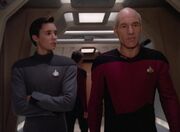
A provisional officer's uniform alongside a standard duty uniform
Starfleet uniforms were uniforms worn by individuals serving in the Federation Starfleet , originally a United Earth organization. These uniforms facilitated the wearers' needs as both scientists and researchers , as well as Starfleet's military role. The uniform and combadge used by Starfleet personnel may vary by the ship or facility they were assigned to, or the officer's rank or department. These were often retained even when visiting other Federation locations. ( TNG : " The Child "; DS9 : " Homefront ", " Tears of the Prophets "; LD : " We'll Always Have Tom Paris ", " Kayshon, His Eyes Open "; DIS : " Saints of Imperfection ")
Casual duty attire also allowed for considerable variation of uniform aboard a Starfleet vessel, though it was ultimately up to the captain's discretion. Wearers were expected to abide by the Starfleet dress code , though special exceptions were sometimes made for certain aspects of an individual's cultural heritage, such as Worf 's Klingon baldric , Nog 's Ferengi headdress , and the earrings of Ro Laren , Kira Nerys , and Shaxs . ( VOY : " Learning Curve ", et al.) According to Elim Garak , " I think Starfleet should allow their officers more latitude in accessorizing their uniforms. You'd be surprised what a nice scarf can do. " ( DS9 : " Broken Link ")
On two occasions, the term " Federation uniform " was used to describe Starfleet uniforms.
In 2369 , the Bajoran civilian Mullibok , who was being evicted from his home , asked Commander Benjamin Sisko how many Federation uniforms he planned on sending down to have him removed. ( DS9 : " Progress ")
In 2372 , Chakotay referred to his as a Federation uniform as he explained to Kar how it was like the Jal name that the Kazon earned. Chakotay told him that his uniform was earned through " years of study ", and " learning about science and ships and navigation , " adding too, that he was further taught to be "[..] prepared us to defend ourselves in battle. They prepared us very well. And we had to pass many difficult tests before we were given the right to wear the uniform. " ( VOY : " Initiations ")
- 1.1 Command
- 1.2 Operations
- 1.3 Sciences
- 2.1.1 Type #1
- 2.1.2 Type #2
- 2.1.3 Type #3
- 2.1.4 Type #4
- 3 Uniform variations
- 4 Dress uniforms
- 5.1.1 Design
- 5.2 Ambiguous uniform
- 5.3 External links
Divisions [ ]
Starfleet uniforms were classified by color among the command, sciences, and operations divisions. Occasionally, the uniforms were also broken down by department, while displaying rank insignia conspicuously. The color scheme had varied over time throughout Starfleet history, but the uniforms were designed for comfort even in the most extreme environments. ( DS9 : " Trials and Tribble-ations ", " Let He Who Is Without Sin... ")
Command [ ]
The command division was the head of Starfleet, with most of the ranking officers in Starfleet Command wearing these colors. Generally, this division was responsible for the administration of starships , starbases , and space stations .
Operations [ ]
The operations division was the backbone of Starfleet, encompassing the engineering , security , and support departments. This division was responsible for technological innovation and for maintaining and defending the Federation.
Sciences [ ]
The sciences division was the heart of Starfleet, composed of the exploratory , medical , and mental health departments.
Uniform styles [ ]
Unknown eras [ ].
These Starfleet uniforms were introduced between the 24th and 31st centuries .
Type #1 [ ]

A female officer in an unknown uniform
This uniform was worn by an operations division officer , as seen in a photo within the Transporter Facility maintained by Chief Petty Officer Carlton Dennis . ( LD : " Grounded ")
Type #2 [ ]
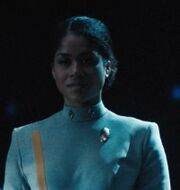
A female junior officer in a uniform from an unknown era
This uniform was worn by one of Tal 's hosts . ( DIS : " Forget Me Not ")
Type #3 [ ]
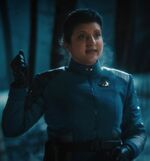
A holographic representation of a female lieutenant
This uniform was worn by officers in an unknown era. ( DIS : " Su'Kal ")
Type #4 [ ]
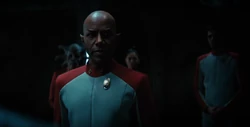
Holographic representations of officers in uniforms from an unknown era
This uniform was worn by the delegation welcoming the Kelpien and Ba'ul Alliance into the Federation. ( DIS : " Su'Kal ")
In the 23rd century , similar uniforms had been in use as cadet outfits. ( DIS : " Through the Valley of Shadows ")
Uniform variations [ ]
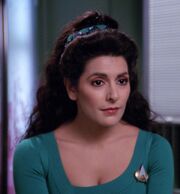
Troi in her casual attire
Some officers wore alternate uniforms. Deanna Troi often wore casual clothing while on duty, and T'Pol retained her original Vulcan uniform with a few concessions to her Starfleet rank and ship assignment. Other officers, such as Worf, Montgomery Scott , and Ro Laren, were allowed to wear accessories relating to their culture with their uniforms, but this was at the discretion of the captain. Uniforms were also altered to accommodate non-humanoid officers, such as the three-armed, three-legged uniform of the Edosian Arex , and the uniforms for beluga whales Kimolu and Matt . ( ENT : " Borderland "; Star Trek II: The Wrath of Khan ; TNG : " Ensign Ro "; TAS : " Mudd's Passion "; LD : " First First Contact ")
Uniforms were also adapted to environmental or atmospheric conditions. When exploring the planet Tyree , Benjamin Sisko and colleagues wore long, flowing gown uniforms to deal with the sand . They featured a colored stripe to represent departments. ( DS9 : " Shadows and Symbols ")
Dress uniforms [ ]
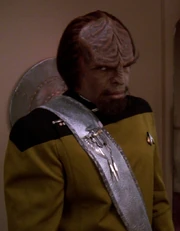
Worf wearing his dress uniform with a Klingon ceremonial sash
Dress uniforms were a variant of the standard Starfleet uniforms worn for special occasions, such as weddings , courts martial , funerals , and the greeting of ambassadorial delegations and heads of state. ( TOS : " Court Martial ", " Journey to Babel "; TNG : " Lonely Among Us ", " Manhunt ", " Data's Day "; DS9 : " Move Along Home ", " Rules of Engagement "; VOY : " Course: Oblivion ", " One Small Step ", " Ashes to Ashes "; Star Trek: Insurrection )
Appendices [ ]
Background information [ ].
Patrick Stewart 's character of Jean-Luc Picard has appeared in more styles of Starfleet uniform than any other character on screen without story contrivances (like time travel , holodecks , or alternate timelines ) being involved.
For most of Star Trek 's history, Starfleet uniforms have had at least three division colors. Some characters have worn different division colors in different episodes. Leslie , Jae , Tom Paris , Harry Kim , and Sylvia Tilly have each been shown wearing three colors at different points (including, for Paris and Kim, alternate timelines and holodeck scenarios); however, the first character to wear all three division colors in one episode was Ensign Sam Rutherford , who wore operations gold, command red, and medical blue in LD : " Envoys ".
The Starfleet uniforms worn during Star Trek: The Original Series were designed by William Ware Theiss , who returned to design the Star Trek: The Next Generation uniforms (which were further adapted into future versions on Star Trek: Deep Space Nine , Star Trek: Voyager , and the TNG -era films by Robert Blackman ). Robert Fletcher designed the uniforms seen throughout the original series movies, with later new designs provided by Nilo Rodis .
Robert Blackman also designed uniforms worn on Star Trek: Enterprise , a design representing a precursor to those seen in TOS . The uniforms seen in Star Trek: Discovery were designed by Gersha Phillips . The uniforms in Star Trek: Picard were designed by Christine Clark .
Michael Kaplan designed the uniforms seen in Star Trek and Star Trek Into Darkness , and Sanja Hays designed the uniforms for Star Trek Beyond .
As shown in the It's A Wrap! sale and auction , a number of Starfleet uniforms have had padding to increase muscular appearance. Such cases include two costumes for Tom Paris , one racquetball costume for Julian Bashir , and a Deep Space Nine costume for Worf, to create a more Klingon appearance. According to Wil Wheaton , all the main cast members wore muscle padding during the first two seasons of The Next Generation , mainly because of the tight-fitting nature of the spandex uniforms used in these two seasons. [2]
Several prototype uniform undershirts to those seen in Star Trek II: The Wrath of Khan on were sold off on the It's A Wrap! sale and auction on eBay. [3]
Ambiguous uniform [ ]
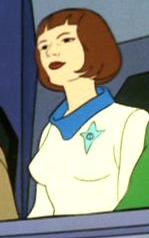
Female on the Elysian Council
A Human female seen as a member of the Elysian Council in " The Time Trap " wore a uniform of ambiguous origin. It was described in the Star Trek Concordance as "a white suit with blue collar and an insignia on the left breast," and was suggested to "possibly [be] an early Star Fleet [sic] uniform". While it is known that the Bonaventure , and possibly other Earth/Federation ships, were lost in the years prior to 2269, it is unclear if this is indeed a Starfleet uniform, and, if so, from which era it originated.
External links [ ]
- Starfleet uniform at Memory Beta , the wiki for licensed Star Trek works
- 22nd & 23rd century Starfleet uniforms at Ex Astris Scientia
- 24th century Starfleet uniforms at Ex Astris Scientia
- Starfleet uniforms at Spike's Star Trek Page
- Interview with William Ware Theiss at Phaser Resource (X)
- 1 Rachel Garrett
- 3 USS Enterprise (NCC-1701-G)
Screen Rant
Star trek’s starfleet uniform colors: what they mean & why they changed.
From the 22nd century, a gold Starfleet uniform meant command, until it switched from gold to red between Star Trek: TOS and TNG - why the change?
- Star Trek's uniform colors have changed over the years to reflect different meanings and visions of the franchise's costume designers.
- In the original series, blue represented medical and science divisions, gold denoted command positions, and red was worn by engineering, security, and communications divisions.
- The switch from red to gold uniforms in the 24th century was likely a decision made by Starfleet to move away from the negative association with red uniforms ("redshirt" deaths).
Star Trek 's iconic uniforms have through a variety of changes in color designation and design in the past 57 years for a variety of reasons. In Star Trek: The Original Series ' unaired pilot, there were only two colors - blue for the science and medical divisions and gold for everybody else. Due to the costs involved in mounting a second pilot for the network, the gold uniforms were retained for TOS ' successful pilot, "Where No Man Has Gone Before". After that Star Trek embraced the gold, blue, and red uniforms that were an integral part of TOS ' iconic visual style between 1966 and 1969.
The meaning of gold, red and blue have changed over the years and so too has the way that those colors are displayed on the uniform. This is understandable for a franchise that has been running for 57 years. Each new costume designer will have their own vision for how they think Star Trek 's uniforms will look, and which characters would best suit which color. For example, Robert Blackman adapted original Starfleet uniform designer William Ware Theiss' Star Trek: The Next Generation uniforms for the 90s Trek shows and subsequent movies. Although he redesigned the outfits, Blackman honored the new color meanings decided upon by Theiss.
What Star Trek’s Uniform Colors Mean
In the entire history of Star Trek , blue has always denoted that the officer wearing the uniform is attached to Starfleet's medical or scientific divisions. During the 23rd century, the gold uniform denoted command positions and were also worn by Star Trek 's ace helmsman Lt. Hikaru Sulu (George Takei) and navigator Lt. Pavel Chekov (Walter Koenig). The red shirts were worn by the engineering, security and communications divisions. The red shirts also had an unfortunate association with the countless members of Starfleet away teams that were killed in the line of duty. Meanwhile, Kirk's green uniform was usually reserved for diplomatic functions.
By the 24th century there had been a switch around of Starfleet uniform colors and their relevant associations. Captain Jean-Luc Picard (Patrick Stewart) wore a red uniform throughout Star Trek: The Next Generation , rather than a gold one, so too did his Number One, Commander William T Riker (Jonathan Frakes). Meanwhile, the gold uniforms were worn by everybody with an operational role from security down to engineering, with occasional Enterprise-D helmsmen wearing red uniforms, like Lt. Geordi La Forge (LeVar Burton) in TNG season 1.
Why Star Trek’s Uniform Colors Changed
There's never been an in-universe explanation for the red and gold switch between Star Trek 's 23rd and 24th centuries. It can easily be explained by an operational decision made by Starfleet's wardrobe department to break away from the problematic " redshirt " association. Similarly, the more sober gray uniforms in Star Trek: Deep Space Nine and the Star Trek: The Next Generation uniforms could have been designed to reflect the war footing that Starfleet had found itself on while in conflict with the Dominion.
The real-life explanation for why Patrick Stewart and Jonathan Frakes weren't dressed in gold is more interesting, however. There are apocryphal stories that Stewart and Frakes didn't look as commanding in the gold uniforms designed by original Star Trek: TNG costume designer William Ware Theiss. It's certainly true that the dark red uniforms worn by Captain Picard and Commander Riker pop better on screen than the gold uniforms worn by the ops team. More interesting still, Lt. Commander Data (Brent Spiner) was supposed to be in science division blue, but it was a bad color for his pallid android skin tone.
Starfleet Uniform Variants In Star Trek
Interestingly, Scott Bakula's Star Trek: Enterprise went back to the color distinctions from Star Trek: The Original Series. Each of the blue flight suits had colored piping around the shoulders reflecting yellow for command and red for operations. The only notable difference was that Lt. Hoshi Sato (Linda Park) had the blue piping of the science division on her uniform to reflect her role as the Enterprise NX-01's linguist and translator. It's thanks to Hoshi's scientific research into alien languages that Lt Nyota Uhura (NIchelle Nichols) can maintain hailing frequencies in her operational position aboard the USS Enterprise.
Other notable uniform variants are the similarly blue uniforms from Star Trek: Discovery which had gold or silver cuffs and side panels for command and operations, respectively. The iconic crimson movie costumes had different colored turtleneck sweaters under the tunics, presumably to denote crew role. Prior to those iconic crimson outfits were the poorly received monochrome uniforms designed for Star Trek: The Motion Picture , which were sometimes referred to as space pajamas. The longer that the franchise continues into the future, the more likely it is that Starfleet uniforms will continue to adapt and change. However, Star Trek: Discovery 's far future uniforms prove that Star Trek 's command red is very much in style almost a millennium after it was first introduced.
Continuing Mission
A Fan Site for the Star Trek Adventures RPG by Modiphius

Uniform Guide
Welcome to a Star Trek 101 article .

T he intent of this blog is to provide a quick graphical guide of the evolution of the uniform.
Types of Uniform
In most eras, there are two types of uniform: the standard duty uniform and a formal dress variant. Duty uniforms are worn when on shift at a duty station, such as on the bridge or engineering. Dress uniforms are worn on formal occasions, such as diplomatic functions, weddings, and occasional court apperances.
Some eras have additional uniforms. Service or work uniforms are sometimes worn, typically when performing manual labour or similar work. This was especially true of medical staff, who often had labcoats or different coloured uniforms when serving in the medbay, and engineers. Captains also occasionally have casual duty variants, such as wrap-around tunics or jackets.
Cadets attending Starfleet Academy also typically have a variant uniform or badge denoting their trainee status.

Starfleet uses a variant of naval ranks.
Line officers were assigned to a single posting, typically a starship or starbase, which was their sole responsibility. Captains are generally in command and each is assigned to a starship. Beneath them are commanders , who might be officers working their way to the rank of captain and their own command, or simply be a highly experienced officer. In some instances, a commander might be granted command of a space station, colony, or similar posting. When a commander is in charge of a ship, they are given the rank of “acting captain”. In most eras, Starfleet also has the ranks of lieutenant and ensign , with the latter being the initial rank assigned graduates of Starfleet Academy.
Other ranks typically exist, but were not consistently shown. Lieutenant commanders are often recognized (informally addressed as “commander”, typically by more junior officers). The rank of lieutenant junior grade is sometimes also recognized, falling between the rank of ensigns and full lieutenants.
Above captains and not assigned a single ship were flag officers. Commodores were the lowest flag officers, falling between captains and admirals and commanded multiple ships in field operations. On occasion, this rank would be replaced/ renamed fleet captain . Above commodores/ fleet captains were admirals who were in charge of fleets of starships, entire sectors of space, or divisions of Starfleet. Admirals are subdivided into rear admirals , vice admirals , admirals , and fleet admirals in increasing order of superiority. Fleet admirals reported to the Commander in Chief of Starfleet, who was the senior fleet admiral reporting to the Federation Council and its president.
On most starships there are a number of “ noncoms ” or non-commissioned officers: crewmembers who did not graduate from Starfleet Academy. In some instances these are not distinguished and treated as ensigns or lack a display of rank. At times when differentiation between noncoms was needed they are given the ranks crewman , specialist , petty officer , chief petty officer , senior chief petty officer , and master chief petty officer . Higher ranking noncoms, such as senior and master chiefs, could have decades of experience and included among the senior staff of a starship or starbase, but were technically below a rookie ensign in rank.
In theory, there are also warrant officers in Starfleet: trained specialists whose expertise in a field grants them an informal commission. Despite not having attended the Academy, a warrant officer would have a rank equivalent to an ensign, lieutenant, or higher. However, no warrant officers have been identified as such on the show. In their place Starfleet potentially uses provisional or honorary ranks.

Description: The uniform of the United Earth Starfleet is a navy blue jumpsuit. This uniform was worn until the founding of the United Federation of Planets, including the period of the Earth-Romulan War.
It’s one of the few designs with pockets.
Division Colours: A strip of colour framing the shoulders denoted the officer’s department. Yellow was command, red was operations (security and engineering), and teal was sciences (medical and science)
Badge: Circular assignment patches on the left arm denoted the officer’s ship.
Rank: Rank was denoted with rectangular pips on the upper right breast.

Description: This was presumably the first uniform of the United Federation Starfleet. Similar to the Earth Starfleet jumpsuit, this uniform is a utilitarian light grey jumpsuit with coloured patches on the shoulders and cuffs as well as stripes down the chest and pants. The assignment patch on the upper arm remains, signifying the officer’s assigned ship.
Division Colours: The patches and stripes denote the wearer’s department: yellow is command, red is operations, and blue is sciences.
Badge: Gold pins of the Starfleet delta were worn on the left breast.
Rank: Unknown. No rank emblems seen on-screen.

Description: A minimalistic change from the jumpsuits, this two-piece uniform featured dark trousers and coloured tunic. A raised stripe of piping ran along the upper arms and across the chest.
Division Colours: The shirt denoted the officer’s department. Command wore blue, operations wore tan/gold, and sciences wore grey.
Badge: A raised silver outline of the Starfleet delta was on the left breast.
Rank: The shirt’s sleeve had metallic bands denoting rank.

Description: A tight two-piece blue uniform with metallic highlights on the shoulders and along the sides of the torso.
Division Colours: The huge of the metallic highlights denote division. Gold is command, silver is sciences, and bronze is operations.
Badge: Two-piece metallic insignia badges are worn on the left breast. The colour of the badge matched the metallic department colour of the rest of the uniform.
Rank: Raised bumps on the insignia badge identify an officer’s rank. The captain’s shoulders features additional gold highlights.
Note: Ostensibly, this uniform should be the same as the uniforms seen in early episodes of The Original Series , which takes place at roughly the same time. Tie-in novels state the brighter uniforms were newer diplomatic uniforms being phased in, starting with the exploratory Constitution -class starships.

Second Note: On Discovery several officers with black badges were shown. These were not identified on the show, but a deleted scene identified the black badge as belonging to Section 31. Why Section 31 would identify themselves or have Starfleet badges (when they were a separate organisation) is unknown.

W here It Was Seen: Star Trek The Original Series (the two pilot episodes: The Cage and Where No Man Has Gone Before )
Description: A coloured turtleneck sweater with dark trousers.
Division Colours: The colour of the shirt denotes division. Yellow for command, blue for science, and tan for operations.
Badge: Assignment patch worn on the left breast. It’s unknown if every ship had its own patch, like in the 2260s, or if every ship had the Starfleet delta.
Rank: Golden braids on the sleeve denote rank. Not all ranks were seen on-screen during the few episodes these uniforms were worn.

Description: A brightly coloured shirt with black collar with dark trousers.
Division Colours: The officer’s shirt colour signifies their department: yellow is command, blue is science, red is operations.
Badge: In place of the Starfleet delta insignia on the left breast, all ships and stations had their own unique assignment patch; the Federation’s flagship, U.S.S. Enterprise , retained the delta.
Rank: Golden braids on the shirt’s cuffs denote rank.
Note: This uniform was seen in The Original Series and theoretically also shown in the Kelvin Timeline films. In the first two Kelvin films, the black collar is instead a black undershirt and the coloured top is textured with Starfleet deltas. In Star Trek Beyond , the top is a heavier jacket with a high collar.

Description: Muted blue, white, beige, or grey uniforms. These uniforms came as jumpsuits or two-pieces with matching top and trousers.
Division Colours: The colour of the circle behind the unform’s printed insignia denoted the officer’s department. A white circle signified command, orange is sciences, green is medical, red is engineering, yellow is communications and helm/ navigation, while grey is security.
Badge: The Starfleet insignia was printed on the left breast.
Rank: Golden braids along the sleeve or on shoulder patches denote rank.

Description: A crimson tunic worn over a colour-coded turtleneck undershirt. The uniform’s dark trousers featured a coloured stripe running down the leg that matched the undershirt (except for command officers, who had a red stripe).
Division Colours: An officer’s department was identified by the colour of their undershirt, shoulder clasp, and a stripe running down their trousers. White was command; grey was sciences, communication, and navigation; ochre was engineering and helm; light green was medical; dark green was security; and red was cadets and junior officers. Non-coms wore jumpsuits, but also had black undershirts.
Badge: A metal variant of the Starfleet insignia with a large rectangular backing was worn on the left breast.
Rank: A metal badge worn on a shoulder clasp denoted rank.

Note: A long serving uniform, this design was used until the 2350s. In later years the belt and turtleneck ceased to be worn and the insignia pin was replaced by a combadge.

Early 2360s

Description: A tight one-piece jumpsuit with a low collar. The chest, back, and sleeves were brightly coloured, as was a stripe running along the collarbone and shoulders.
Division Colours: The colouration of the upper jumpsuit denoted department. Command was red, operations was yellow, and sciences was blue.
Badge: All officers wore a combadge: a silver delta backed with a golden oval that functioned as a communicator.
Rank: Round gold pips on the upper right breast denote rank.
Where It Was Seen: Star Trek The Next Generation (seasons 3 onward)
Description: A looser two-piece modification of the earlier jumpsuit with a high collar.
Division Colours: The jacket’s colour was associated with the wearer’s department: red for command, yellow for operations, and blue for sciences.
Badge: A communicator shaped like a silver delta with a golden oval backing was worn on the left breast.
Rank: Gold pips worn on the right collar denoted the officer’s rank.

2360s (Variant)

Description: Dark trousers and jacket worn over a blue-grey turtleneck undershirt. The shoulders of the jacket were brightly coloured.
Division Colours: The colour of the shoulders denoted one’s department. Red was command, yellow was operations, and blue/ teal was sciences.
Badge: A communicator was worn on the left breast. Initially this combadge was a silver delta backed with a golden oval. In the late 2260s and early 2270s this was replaced with an updated model that substituted a trapezoidal shape for the oval.
Rank: Gold pips worn on the right collar of the undershirt denoted rank.
Note: This variant was service dress, or “work uniform”. It was typically worn on less formal posting, such as space stations and colonies where more “hands on” work might be required. When the current duty uniform was being phased out, this variant saw regular use for a year or two.

Description: A dark jacket with light grey shoulders and matching trousers worn over a coloured undershirt.
Division Colours: The colour of the undershirt was associated with the officer’s department. Red was command, yellow was operations, and blue was sciences.
Badge: Combadge worn on the left breast: a silver Starfleet delta backed by a gold trapezoid.
Rank: Round gold pips worn on the right collar of the undershirt signified rank.
Where It Was Seen: Star Trek Picard
Description: A dark jacket with matching trousers with coloured shoulders and bands along the flared cuffs.
Division Colours: The colour of the shoulders and cuffs denoted one’s department. Red was command, yellow was operations, and blue was sciences.

2390s (Alternate)

Description: A double-breasted jacket with high waisted dark trousers. Black piping ran along the chest and shoulders.
Division Colours: An officer’s department was displayed by their jacket colour. Red was command, blue was science, and yellow was operations.
Badge: A combadge was worn on the left breast. The badge was a silver outline of a delta backed by two gold trapezoids
Rank: Gold round pips worn on the upper right breast above the black piping.

Description: Dark trousers and jacket worn over a black turtleneck undershirt. The shoulders of the jacket were brightly coloured.
Division Colours: The colour of the shoulders denoted one’s department. Red was command, yellow was operations, and blue was sciences.
Badge: A combadge was worn on the left breast. The badge was a silver outline of a delta backed by two silver trapezoids
Rank: Silver round pips worn on the upper right breast.
2410s (Potential)

Description: A dark jacket and trousers worn over a coloured undershirt. The jacket has a high collar with a wide band of colour running along the chest and shoulders. In officers, the shoulders above the coloured band are dark grey, while the commanding officer’s shoulders are white.
Division Colours: The undershirt and coloured band signify an officer’s department. Red is command, blue is sciences, and yellow is operations.
Badge: A combadge is worn on the left breast, shaped like a solid silver delta.
Rank: Silver rectangular pips on the right collar.
Share this:
As a retired 23 year Senior Master Sergeant of the USAF your statement concerns me, as it lacks an important concept of the Military community:
“Higher ranking noncoms, such as senior and master chiefs, could have decades of experience and included among the senior staff of a starship or starbase, but were technically below a rookie ensign in rank.”
while technically true, does not really explain the mentoring that occurs between these Senior NCO’s and the lower ranking Officers. These Junior Officers live in a world where “Officers eat their young” and the SNCO’s keep them from getting beaten up by the Colonels (Captains in Navy and Starfleet speak).
Long love the NCO rank and God help the Officer who forgets the value of his mentor.
Scott Reu, USAF, SMSgt (Ret)
Great comment! Nice to get feedback like this and a real world perspective. I like to think, in the more idealistic/ positive future of Star Trek that the relationship between senior and junior officers is a little less adversarial.
I like to think I touched on the mentoring slightly in my article on playing NCOs: https://continuingmissionsta.wordpress.com/2018/04/11/playing-enlisted-officers/
- Pingback: Star Trek 101: Table of Contents – Continuing Mission
The uniforms from DSC and theif Enterprise version are made after the uniforms from The cage story which is taking place 13 years before Kirk’s era,DSC is taking place with 10 years (9 years for the season 2) before Kirk’s era.
Yeah, this gets into funky continuity territory. Mostly because Discovery didn’t care much for continuity so we have to handwave explanations.
As you say, Starfleet should be using the colourful jumper/pajama uniforms seen in The Cage before Discovery, which are also seen in the first Kirk episode, Where No Man Has Gone Before.
The explanation given in the novels is that Discovery and Starfleet command is using an older blue uniform with metallic highlights, while the flagship of the Federation and other exploratory craft get the new brightly coloured shirts a few years early. (This is the explanation I assumed at the time of writing this blog.) Alternatively, exploratory ships are given different uniforms in that era.
The trailers of Discovery season 2 complicate this and raise a different continuity issue as Pike has yellow tunic but a dark collar and Operations has red rather than tan. It might be easier to declare the uniforms of WNMHGB and The Cage non-canon and just jump right from DIS to the Kirk/TOS uniforms.
Leave a Reply Cancel reply
This site uses Akismet to reduce spam. Learn how your comment data is processed .
Discover more from Continuing Mission
Subscribe now to keep reading and get access to the full archive.
Type your email…
Continue reading


Star Trek's Different Uniform Colors And Their Meanings Explained
T he Starfleet uniforms seen on the original "Star Trek" series back in 1966 were designed by William Ware Theiss, a costume designer who had previously worked on major Hollywood productions like "Spartacus," and who would go on to design for films like "Harold & Maude," "Bound for Glory," and "Pete's Dragon." According to an article on StarTrek.com , Theiss became friends with D.C. Fontana on the set of "Spartacus" (Fontana worked as a member of the studio's typing pool), which gave him the connection he needed to land his "Star Trek" job. It was Theiss' idea to make futuristic space uniforms look more shirt-like and casual, which stood in contrast to the shiny-and-chrome sci-fi costumes that were more in vogue at the time.
Theiss was also notorious for the skin-revealing outfits he designed for the show's many female guest stars, and he was noted for being able to ride the line of acceptability when it came to nudity. He was a talented man whose name should be more widely known by Trekkies.
The actual colors of the Starfleet uniforms, however, were decided by committee (with Fonanta and show creator Gene Roddenberry giving input), so Theiss went along with the idea that the various workers on a Federation starship should be color-coded by their respective departments. Little could Theiss have known that the Starfleet department colors would remain a permanent fixture in a media franchise that would last (as of this writing) 57 years.
As far as Starfleet is concerned, there are three central departments on a Starfleet vessel: Gold is for command, blue is for science/medical, and red is for engineering/security. In the days of "Star Trek: The Next Generation," the red and gold would be inverted. Theiss won an Emmy for "Next Generation" before his death in 1992.
Read more: Why Khan Noonien Singh Casts A Shadow Over The Entire Star Trek Universe
Gold, Red, Blue, And Other Uniform Colors
In the original "Star Trek," for instance, one might note that Captain Kirk ( William Shatner ) wore a gold uniform. That was to denote his position in management. Other lower-ranking officers in gold uniforms were essentially on the "management track," presumably learning about all departments on a starship and hoping to command a vessel of their own someday (or at least become a first officer).
Those in the red uniforms worked with the technical aspects of a ship. Scotty (James Doohan) and Uhura (Nichelle Nichols) dealt with machinery, engines, communication devices, etc. Red was also used for security officers on the U.S.S. Enterprise, which may be why so many redshirts died on away missions; they were ancillary security officers. Red uniforms were also worn by yeomen, who essentially helped with clerical work and didn't have a rank. It's worth noting that in the canon of "Star Trek," engineers, yeomen, and security officers don't have to attend Starfleet Academy to serve on board a starship. One can simply enlist. Those officers answer to the heads of their respective departments.
Those in blue, like Spock (Leonard Nimoy) and Dr. McCoy (DeForest Kelley), are in charge of scientific research and medicine. A lot of "Star Trek" is devoted to the sciences, so it makes sense that it would be an active and enormous part of any ship. The science/medical department is pretty self-explanatory.
One might note that Kirk occasionally wore a green tunic with a V-neck collar. The green uniform didn't denote any unique department and seemed to be a regulation fashionable alternate for starship captains. If a captain was bored with their standard gold uniform, they were allowed -- on casual Fridays? -- to wear the green one.
The All-Red Uniforms
In director Robert Wise's 1979 film "Star Trek: The Motion Picture," the uniforms were updated. The crew all wore disco-ready bodysuits that were, likewise, color-coded by department. Command officers now wore all-white outfits, science officers wore a muter steel blue, and engineers wore a muted golden brown. Looking close, one might also note that the Starfleet insignias on officers' left lapels were also color-coded, and the coloring system seemed to be more elaborate for the badges. Command officers wore white, science officers wore orange, medical officers wore green, engineers wore red, operations officers wore gold, and security officers wore silver. "The Motion Picture" was the only "Star Trek" outing to use this code.
"Star Trek: The Motion Picture" also revealed that officers seemed to have many fashionable alternatives to their standard uniforms, and multiple uniform cuts and tunics could be seen around the ship. Occasionally, it seems that Starfleet goes through fashion phases where it becomes lax and less stringent about the uniformity of its uniforms. These "any uniform will do" phases seem to last about a year before Starfleet cracks down again.
Hence, in "Star Trek II: The Wrath of Khan," a new standard was put into place, and the all-red, Christmas sweater-like uniforms (seen in the picture above) would remain the standard through at least the 2350s when the Enterprise-C was commissioned. Those uniforms looked awfully hot but had button-down, shoulder-fastened chest flaps that could be opened to cool off a little. One might note that the subtle department colors were included on the uniform's collars, cuffs, and shoulder straps. Command officers wore white, engineer/security officers wore orange, and science/medical officers wore grey.
The Red/gold Flip
William Ware Theiss returned to "Star Trek" to design the uniforms seen on "Star Trek: The Next Generation," and the design reverted to the red/gold/blue color coding from the original series, only now with the red and the gold reversed; commander officers like Captain Picard (Patrick Stewart) wore red while engineering/security now wore gold. There has been no explanation in the canon of "Star Trek" as to why the department colors flipped. Some fans have theorized the red/gold flip was a production decision made to confront the "redshirts always die" cliché that has wormed its way into the Trekkie's pop consciousness. If the captain wore red, then audiences would no longer assume that those in red uniforms were doomed.
The "Next Generation" color coding system has stayed in place until this day. Those colors remained unchanged in "Star Trek: Deep Space Nine," "Star Trek: Voyager," and the four "Next Generation"-inspired feature films. More recently, "Star Trek: Lower Decks," which takes place about 10 to 15 years after "Next Generation," boasts the same coding. The general uniform designs have changed a lot, but the coloring remains consistent.
On "Next Generation," Picard also might be seen wearing a grey uniform with a suede-like red jacket thrown over it. Like Kirk's green tunic, this seems to be a special fashion dispensation for captains. One might also note that Wesley Crusher (Wil Wheaton), who served as an acting ensign on the U.S.S. Enterprise-D, wore a grey/dark grey body suit. This was the uniform given to provisional officers; Wesley hadn't gone to Starfleet Academy yet and wasn't an official ensign.
The Distant Past, The Distant Future
The 2001 series "Star Trek: Enterprise" is set a century before the events of the original "Star Trek," and the show's costume designers came up with a wonderful uniform design that rests comfortably on a timeline between NASA and Kirk. The crew all wore functional, indigo-colored jumpsuits, replete with pockets and zippers, that bore their department colors on stripes seen over their shoulders. Because "Enterprise" takes place long before the notorious red/gold flip, command officers still bear gold stripes, while engineering/security officers wear red ones. The science officers have always worn blue.
Also set before the events of the original "Star Trek" was the 2017 series "Star Trek: Discovery," which featured a pretty drastically different uniform design. The characters wore all-blue uniforms that featured chrome-encrusted highlights on their sides and wrapped around their shoulders to denote their departments. On "Discovery," command officers wore shiny gold, science officers wore shiny silver, and engineering/security officers wore shiny bronze. Medical officers were permitted to wear all-white uniforms, a trend also seen in the chronologically concurrent "Star Trek: Strange New Worlds." That series adhered more directly to the 1966 designs and colors.
In the third season of "Discovery," a time warp threw the characters into the 32nd century, and, naturally, Starfleet uniforms had changed. The cut of the uniform was very different; the ranking pips were displayed in multiple ways all over an officer's body. Sometimes, the uniforms were grey with department colors denoted on down-the-chest stripes. Sometimes, they were all one color.
For clarity's sake, however, the "Next Generation" era color coding remained intact on 32nd-century "Discovery," something that seems to have lasted the better part of a millennium. The biggest change: medical officers now wear white instead of blue.
Read the original article on /Film .
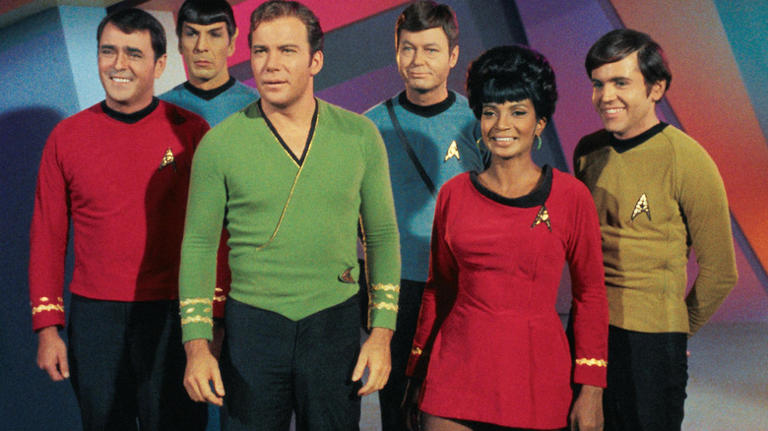
- More to Explore
- Series & Movies
Published Mar 5, 2021
You Wear It Well: The Uniforms of Star Trek
Turns out, "dress for the job you want, not the job you have," might still be a phrase heard in the 23rd Century and beyond!
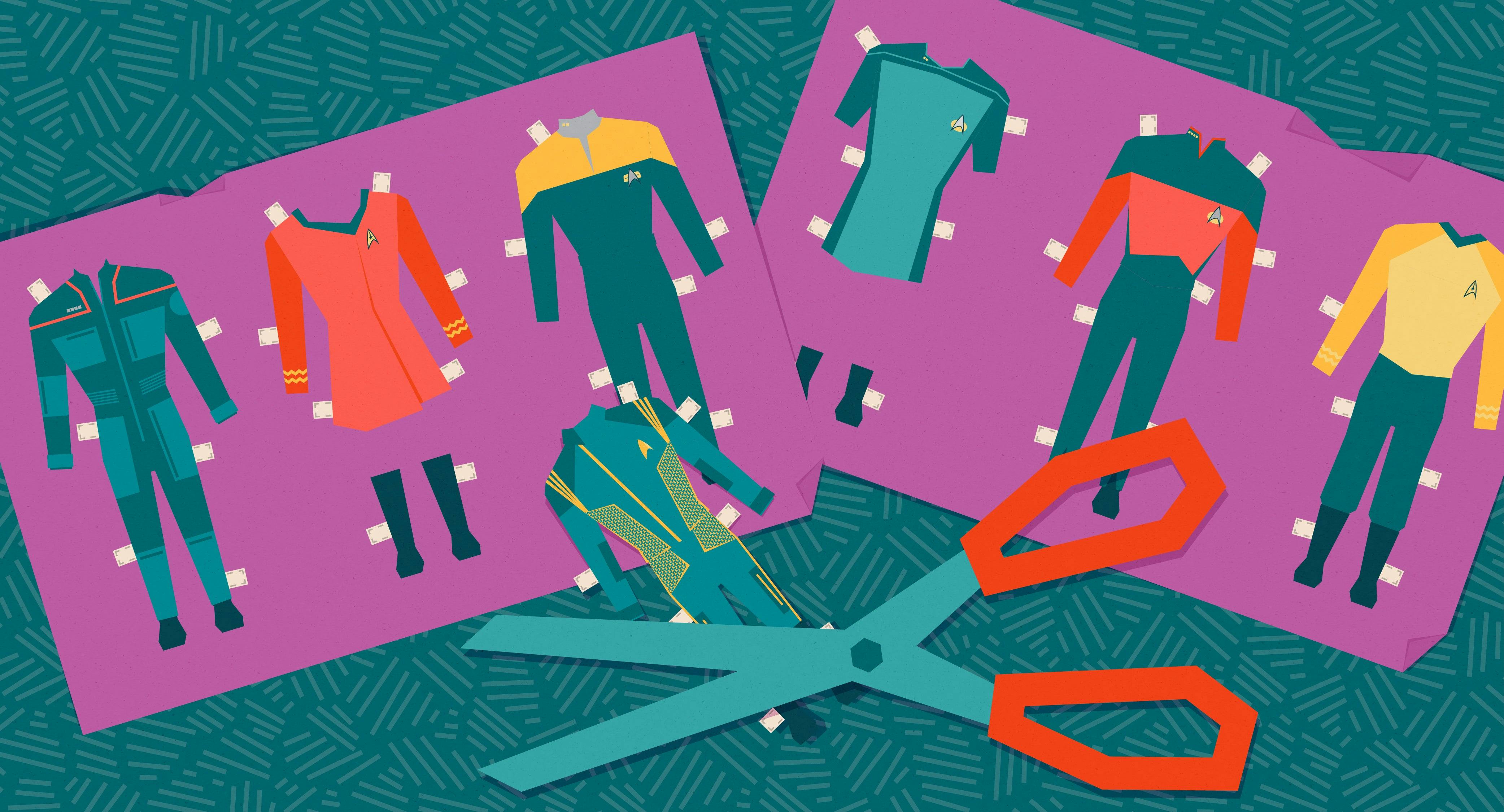
StarTrek.com
The Delta Shield. The colors: red, gold and blue. The form-fitting jackets and often black trousers. Even the confining jumpsuits. Star Trek uniforms have a special place in pop culture, equal in renown maybe only by the jerseys and full kits of certain sports teams. Let’s take a look at some of the uniforms over the years and what messages they are sending to the galaxy.
Star Trek: Discovery — Of Terran Capes And Crowns with Gersha Phillips
Star Trek: The Original Series

The TOS uniforms are arguable the most recognized and iconic of uniforms in the canon. They are the blueprint for all other uniforms in Star Trek . While they carry some of the elements from the “The Cage” unaired pilot episode — tunic-like top, Section colors, black capri-length trousers and boots — the cut and fit of the garments are narrower, the colors much sharper and for the women, no pants. Looking back from our vantage point the uniforms feel more inspired by the 1960s' mod culture, or the era’s British rock bands, not what a fleet of earth-based space explorers would be wearing in the 23rd Century. However, the athleisure vibe of it all was as portentous to our time as the TOS-inspired technology and gadgets that we use on a daily basis. Comparing these uniforms from the garments of other space traveling cultures seen throughout TOS is where you can really see the youthfulness of Starfleet. While Romulans’ uniforms echo the turtleneck silhouette, knit fabric and ultra miniskirts of Starfleet, the rigid textures, exaggerated shoulders, and the addition of a scarf or half vest overlays connotes a sense of the authoritarian militaristic society. Comparing the two looks, without context, you wouldn’t be at fault for easily assuming that Starfleet was the newest team in a galactic travel league.
Star Trek: The Next Generation

Star Trek: The Next Generation was all about the jumpsuit, with a touch of individuality. The best examples of this is Lieutenant Worf’s beautiful Klingon military sash or baldric and Lt. Troi’s flowing dresses and jumpsuits. The Next Generation also famously changed command colors from gold to red, ending a fan favorite “red shirt” trope from TOS. You see other examples of Starfleet uniform styles on the flagship Enterprise , including skants and tunics. The men’s TNG dress uniforms could even be worn as dresses due to their somewhat elongated line. However, from a design and storytelling point of view, the jumpsuit's utility is matched with the artful graphic design which evolves easily into the dress uniform’s elegance and formality.
Into the #Starchive Featuring Captain Picard's Uniform
We can see Starfleet’s evolution of mission and the number of lightyears traveled in the precision of the TNG uniform. Interestingly, the need to continuously mirror the delta design — in the shoulders, sleeves, even in the transition from bodice to trousers both section colors, front and back — is like a monogram. For the many species Jean-Luc Picard and his crew will make First Contact with, this uniform conveys a simple message: We are Starfleet.
Star Trek: Enterprise
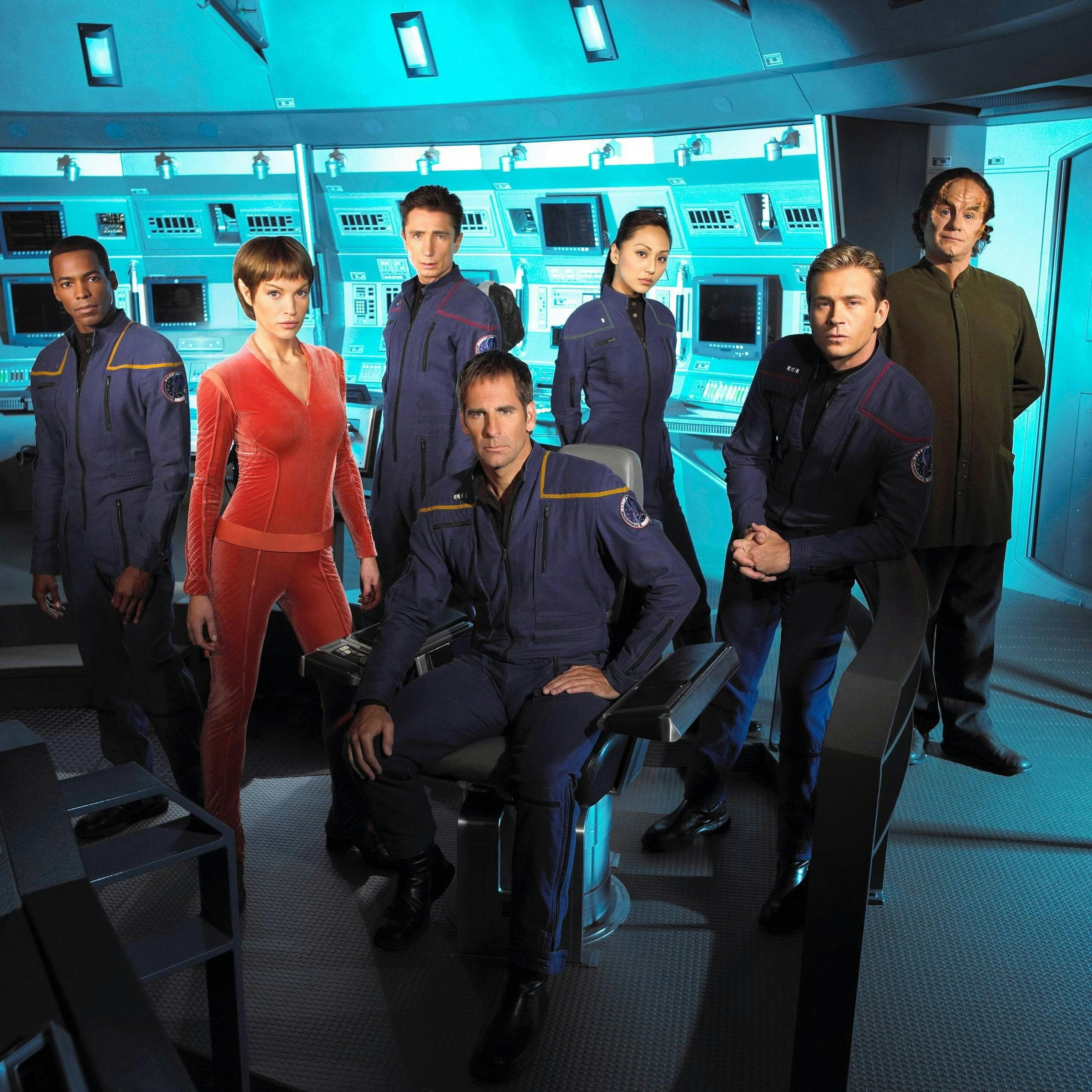
We cannot talk about jumpsuits without talking about Star Trek: Enterprise ! The uniforms on this series most closely represent what our beginnings of further flung space travel might look like. In fact, rather than trying to create something that feels brand new and “science fiction,” the Enterprise crew looks like a team from the National Aeronautics and Space Administration (NASA). The command colors are placed in a simple elegant line framing the shoulders ending, of course, in a point or delta shape. The jumpsuits have the wonderful addition of actual pockets, which actually makes you wonder where all the pockets have been all of this time. Hallelujah — there will be pockets in the future! The jumpsuits are reminiscent of a behind-the-scenes pit or union crew, workers who are laying the important foundation for the future. Yet, similar to workwear from the 20th Century, there is an elegance of how a non-gender specific garment function matches and enhances its form. A more advanced culture may be more fancily dressed, but no one can jump on a nacelle rigging faster than Charles “Trip” Tucker, III.
Star Trek: Deep Space Nine and Star Trek: Voyager
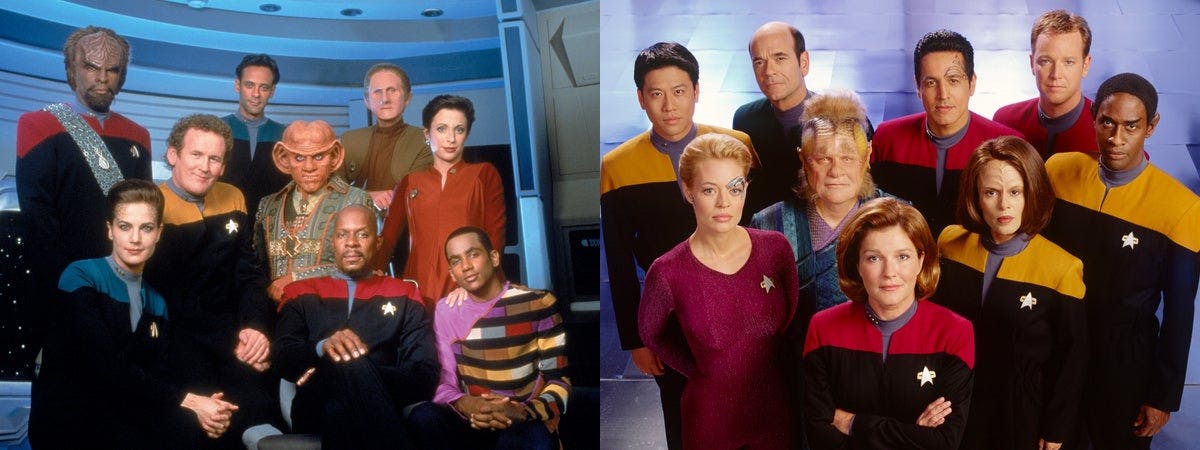
These series combine the streamlined look of the TNG jumpsuit with the function of Enterprise series jumpsuits — jackets, pockets, and pleated trousers. The colors: command red, operations gold, and sciences blue continue with the addition of a mock turtleneck undershirt in grey, which evolves later in a uniform variant where the section colors are the turtleneck and the upper bodice detailing is a quilted grey. Grey as a standard color for Starfleet uniforms appears in Star Trek: The Motion Picture and seen again in Star Trek: Discovery season 3, discussed below.
Into the #Starchive with Captain Janeway's OG Uniform
Deep Space Nine uniforms are particularly interesting in the way all clothes are, in relation to the places and people we associate these outfits with. What makes DS9 unique is the variety of dress everywhere on the starbase, from the Bajoran military uniforms with even more emphasis on the upper bodice and shoulders than Starfleet’s uniforms, to the regalia of the Bajoran monks.In the context of running a space station, Starfleet uniforms need to balance a message of both authority and hospitality. In a sea of colorful people and outfits on the space station’s promenade, the Starfeet uniforms’ relative dark color scheme is the easiest to recognize.
Star Trek: Discovery (Seasons 1-2)
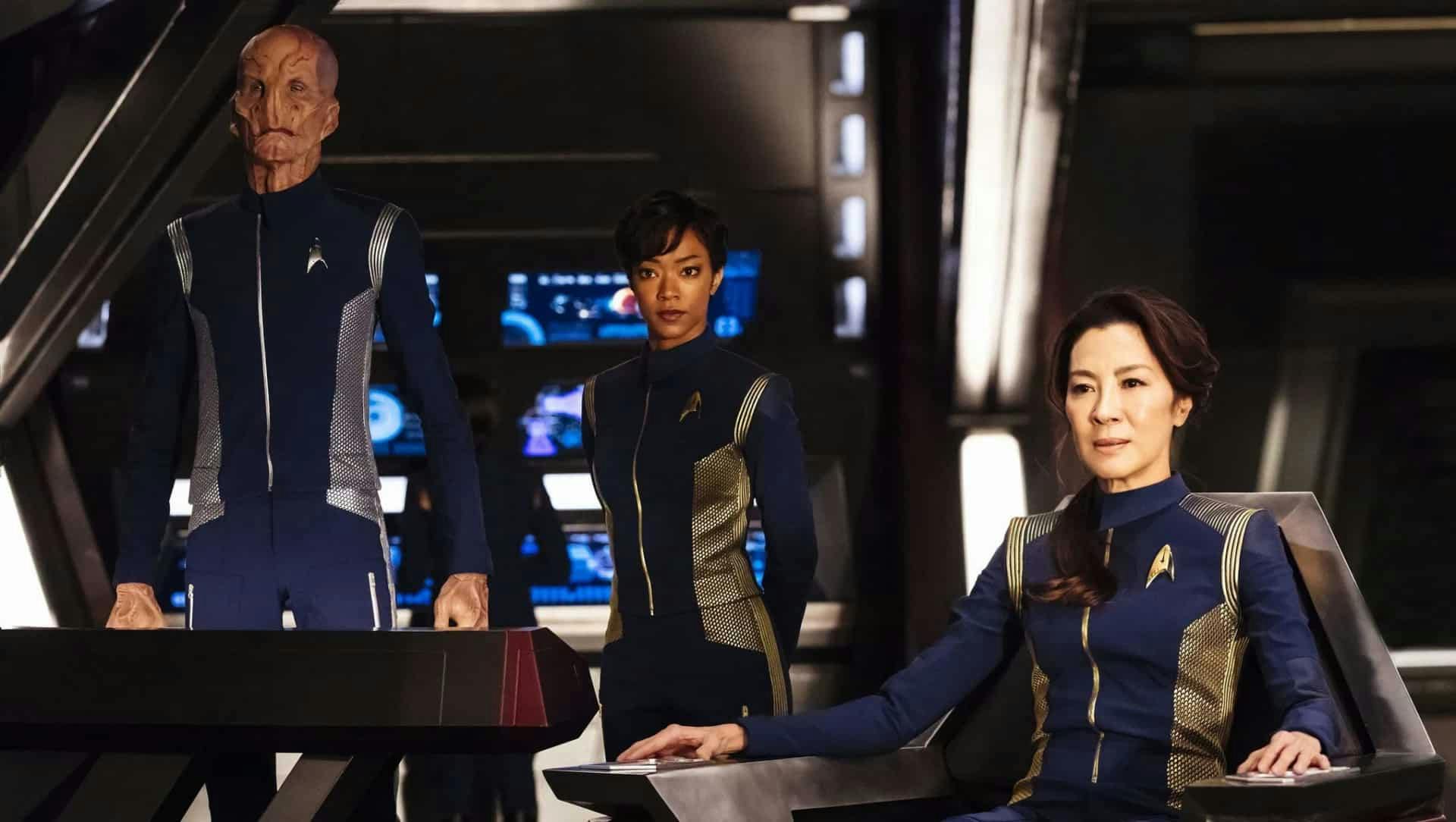
At first glance the Discovery uniforms ignore all previous series. However, there are nods to past series that reveal themselves. While no longer jumpsuits, the jacket, and trouser-leggings of Discovery are blue and thus similar to the Enterprise series. As the series is set between Enterprise and TOS this for me, as a fan, a welcome nod. Most startling is the loss of the iconic red, gold and blue color scheme, it is seen nowhere unless you count the reddish-bronze for Operations. Out of all the series the Discovery uniforms are the most formal. Comparing them to other series, they in fact look like the uniforms of people who have been traveling throughout the galaxy for some time. The form-fitting suit with metal rather than rainbow colors seem to say, “We mean business.” Discovery leans into a militaristic style, more than with previous series. From the rigidity of the jacket to the stripes at the shoulder the uniform appears to, if not welcome , then at least expect conflict and war. The subtle pips on the delta shield could be interpreted to mean that while rank is important, the crew of the Discovery is a family — a band of brothers and sisters equally important and valuable as a captain or admiral. The biggest hint to where this series is going is the asymmetry introduced into Starfleet uniforms for the first time. The eschew collar which creates a delta shape in the front of the face (invoking TOS’ uniform) is closed by a bold metallic zipper that goes from the left of the neck to the center at the jacket bottom. These off-center details could be interpreted to mean that unexpected outcomes are coming!
Star Trek: Discovery (Season 3)
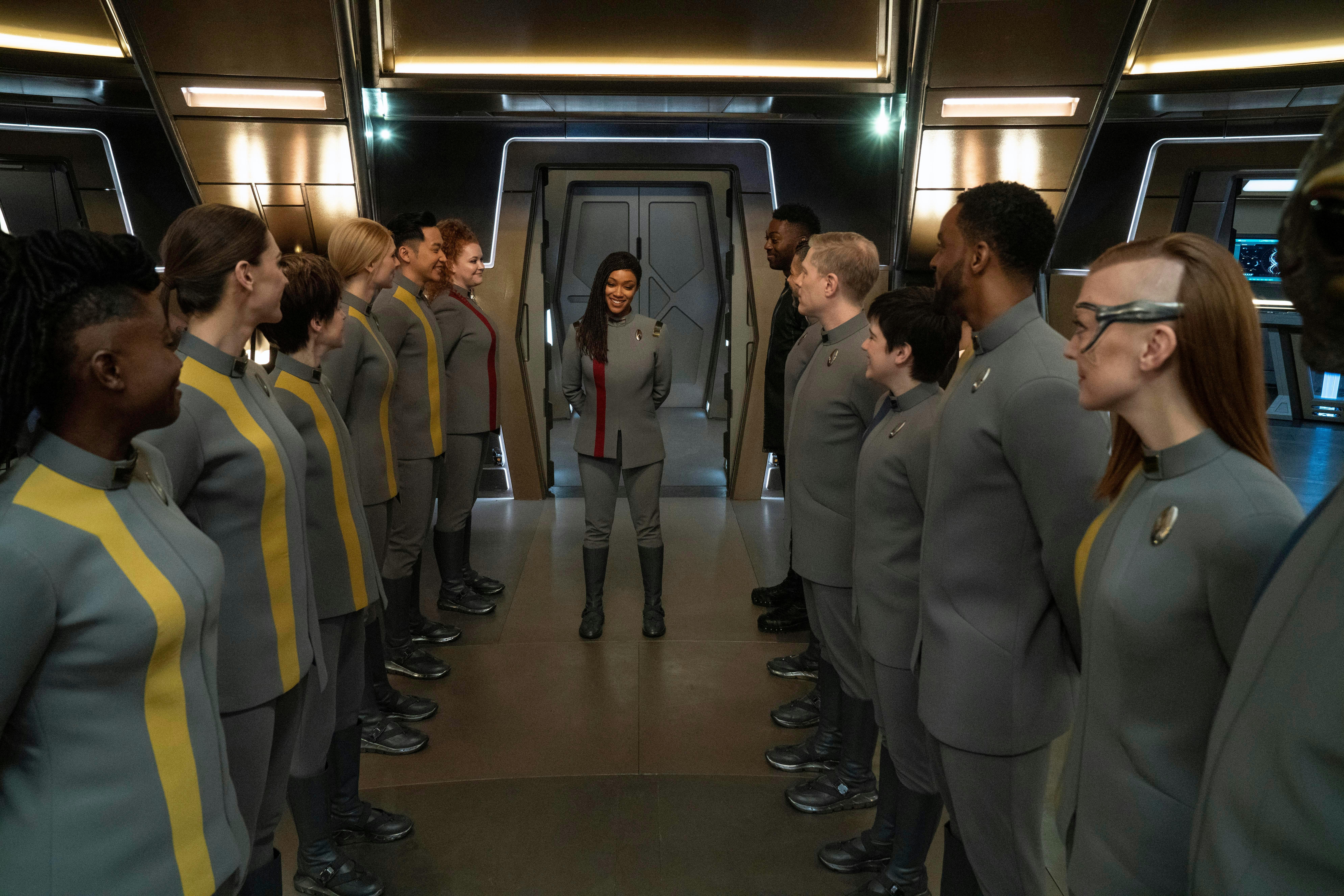
A conversation about Star Trek uniforms would be incomplete without some mention of Season 3’s far-flung future Federation uniforms. It’s not hard to see where these new uniforms took inspiration from other Trek series. In addition to the grey color seen most notably in Star Trek: The Motion Picture , the quilted-ridges at the top of the jacket mirrors that of Deep Space Nine ’s uniforms, and the asymmetry at the bottom of the jacket reminds us of Discovery ’s earlier uniforms. Season 3 even brings back the red, gold, and blue for command, operations, and sciences, this time in a bold sculptural color block down the right side of the jacket. Its appearance seems to state that knowing you and your colleagues’ place in the Federation and on your ship of duty is paramount for rebuilding. This is no time for subtlety. While this same meticulous design could also be overcompensation for the reduction of the Federation’s place, power, and purpose in the 32nd Century it could also be the Federation’s way of “dressing for the job you want (the premiere intergalactic union of planets), not the one you have.” And that’s a tip we can all take with us, to the board room or the Ready Room.
Designer Gersha Phillips Looks Back on Discovery Season 2 Costumes
Bio: Tereneh Idia (she/her) is a writer, fashion designer and fashion educator who has taught and designed in Pittsburgh, New York City, Nairobi, Kenya, Singapore and Bali, Indonesia. While missing out on Star Trek as a child, she expects the rest of her adult growing up to be inspired and entertained by Star Trek.
Star Trek: Discovery streams on Paramount+ in the United States, airs on Bell Media’s CTV Sci-Fi Channel and streams on Crave in Canada, and on Netflix in 190 countries.
Get Updates By Email
What Do the Different Uniform Colors Mean on ‘Star Trek’?
By jason serafino | mar 30, 2023, 3:23 pm edt.
Gene Roddenberry may have dreamed of a perfect future when he created Star Trek , but parts of his vision were firmly rooted in the real world, specifically in the physical makeup of the crew of the Enterprise itself.
Roddenberry, along with the show’s producers, decided to take numerous cues from the United States Navy when creating the official ranks on the show, including a captain overseeing a crew made up of a commander, a handful of lieutenant commanders, lieutenants, and several subordinate roles. But it’s the different colors of the Starfleet uniforms that really tell the story of how the Enterprise operates.
Fans know the basics: an array of blue, red, and gold shirts line the bridge of the ship every episode. Those colors weren’t just randomly picked for the sake of diversity, though. They actually correspond to the ship’s various service roles . The gold shirts are worn by the command division, which includes Captain Kirk, Lieutenant Sulu, and Pavel Chekov. Red uniforms belong to the engineering/communications division, including chief engineer Scotty and communications officer Uhura. The blue shirts are worn by the science/medical staff, including McCoy and Spock .
As with everything in Star Trek , though, it’s a lot more complicated than all of that. In addition to the red shirts belonging to engineers and communications personnel, they are also assigned to the security division. What’s the purpose of the security division on the Enterprise ? Well, they’re usually the supporting characters who are immediately killed whenever the crew is confronted by a new enemy. This is something of a running gag for fans of the franchise, as whenever one of the “Red Shirts” is seen on screen, you know they’re not long for this world .
Also, those gold shirts worn by Kirk and crew might not have been so gold after all. According to an interview with Star Trek ’s costume designer, William Theiss, the idea was for the show’s uniforms to be red, blue, and green. In fact, on the set, Kirk’s outfit certainly looked to be an avocado (or lime) green, but the end result was a little different when the studio lights finally hit the uniform.
“It was one of those film stock things,” Theiss said, “it photographed one way—burnt orange or a gold. But in reality was another; the command shirts were definitely green.”
This might come as a surprise to Trek fans until you remember that Kirk actually did wear green on a few occasions, including the times he was in formal dress and his seldom-seen alternate green get-up, seen in the clip below.
These alternate uniforms were all the exact shade of green Theiss describes, but they were made from a different material than the standard Enterprise shirts and apparently had no issue retaining their natural color scheme when lit on set. The gold shade may have been a production mishap, but the color has since entered the Trek canon as the official hue of Kirk and his command staff. So, in the Star Trek universe, Kirk wears gold; in the real world, though, the bridge of the Enterprise was designed with a completely different color palette in mind.
It gets more confusing when you look at the later Trek series, like The Next Generation , which had the command staff in red and operations in yellow—basically the reverse of the original series. Then, of course, the movies switched costumes and colors with nearly every entry, including the powder blue monstrosities worn in Star Trek: The Motion Picture .
Roddenberry’s eye for detail was unique for sci-fi TV at the time, and everything on the Enterprise had a specific purpose. Despite some production fumbles, ill-fated redesigns, and inconsistencies later on, the colors that make up Starfleet’s uniforms tell a story that many viewers probably never even noticed.
A version of this story originally ran in 2016; it has been updated for 2023.
Star Trek Uniforms Fully Explained
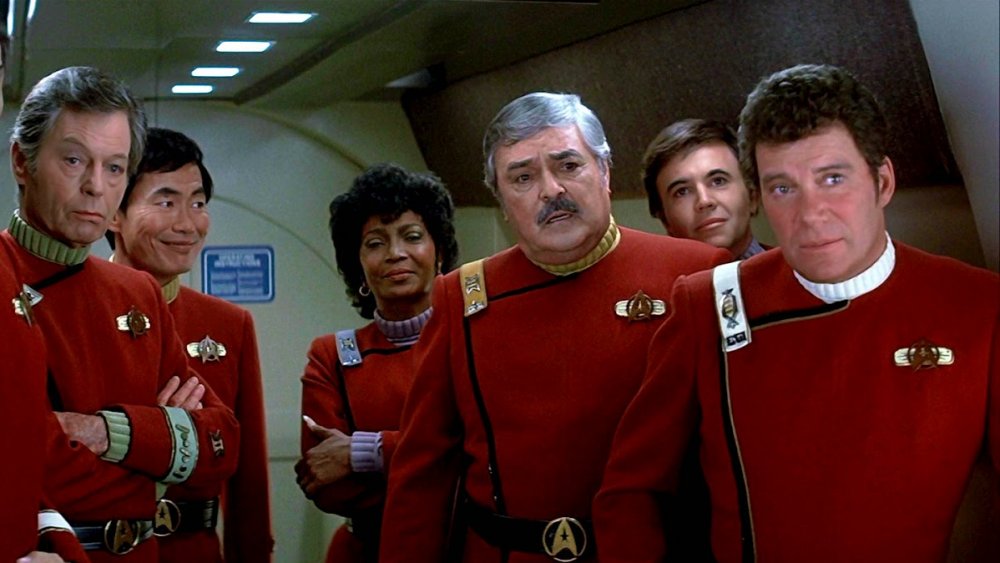
Since its premiere more than 50 years ago, Star Trek has been at the center of a growing web of culture, television, film, and fandom. With nine television series and 13 films, with undoubtedly more to come, there is a wealth of material to analyze and enjoy. Today, an enthusiastic fan can take just a single aspect of the Star Trek universe and dive into it for weeks.
Take uniforms. A seemingly simple concept, right? Star Trek generally focuses on the experiences of people serving in Starfleet, essentially a futuristic version of the Navy in space. So, Starfleet uniforms should be fairly consistent, even boring. Everyone's supposed to look like a cohesive group, so there should be little variation.
However, the uniforms of Star Trek are so varied and connected to the intricate fictional world of the franchise that it's pretty fascinating. Someone appearing on Star Trek: The Next Generation and then showing up again in a film like Star Trek: First Contact will probably have to fit themselves into two very distinct outfits. With more than five decades of stuff to go through, says CNET , there's a dizzying variety of looks for what's supposed to be a pretty staid quasi-military organization.
Practically everything about the history of Star Trek uniforms is linked to behind-the-scenes stories, real-world creativity, in-universe drama, and even a touch of fashion history here and there. From color, to cut, to material, there's a lot to learn.
Color is key to Star Trek uniforms
In Star Trek: The Original Series , which ran from 1966 to 1969, you can't miss the brightly hued uniform shirts sported by the crew of the starship Enterprise . Captain James T. Kirk and other members of the command staff sport golden yellow tops, says Mental Floss . Blue is reserved for the science department and medical personnel, so you'll see it on Mr. Spock, the second-in-command, and the ship's physician, Doctor McCoy.
And what of the folk in red uniforms? According to Star Trek lore, these poor "redshirts" are little more than cannon fodder, though, officially, red is for communications, admin, and security. If you're watching an episode where a random, red-clad crewmember is asked to beam down to the planet with the main cast, don't get too attached. They're probably going to get zapped, eaten, or otherwise annihilated to further the episode's plot.
Of course, there are some exceptions. Statistically speaking, says Nerdist , redshirts are not that bad off. Consider also that red shirts adorn major characters like Scotty, the ship's chief engineer, who made it through the entire series.
Now that you've got that settled, remember that it's only good for one series. In later Star Trek shows, red and gold switched places. Captains like The Next Generation 's Jean-Luc Picard wore a dark red, while his security chief, Worf, wore gold.
Starfleet rank is shown by pips and stripes
Like so many real-world military organizations, Starfleet hinges on rank. Crewmembers are expected to follow orders, but on starships that can carry thousands of people, who are they supposed to take seriously? That's where the rickrack comes in.
In Star Trek: The Original Series , rank was denoted by stripes of gold ribbon on someone's sleeves. The more stripes, the higher the rank. Generally speaking, says Atlas Obscura , two or three stripes means a captain. Commissioned officers are a safe bet for one stripe. Non-commissioned people get either a bit of braid or nothing at all. The stripes were brought back for the reboot films beginning in 2009.
The follow up series, Star Trek: The Next Generation went for something different during its 1987 – 1994 run. The colors became a more muted, and the old rank stripes, which, frankly, looked like something you might have picked up from your local craft store, were retired. In their place, officers wore "pips," subtle little pins, on their collars. The higher someone's rank, the more pips they sported.
Other films played around a bit with the rank symbols, like the different colors and badges shown in 1982's Star Trek II: The Wrath of Khan . Still, they weren't too off the original mark. Generally speaking, the more junk on someone's uniform, the more likely it is that you'll have to follow their orders.
The original series went for velour
Futurama 's Zapp Brannigan character, a send-up of Captain Kirk, is all about his velour uniform. The first Star Trek series really was into luxurious velour, too, but the fabric proved challenging to maintain. It's not as if the 1960s were known for comfortable natural materials, after all.
According to Esquire , the fabric initially used in Star Trek: The Original Series was a little flashy. Costume designers used a stretch cotton velour for the tops, with a black synthetic Dacron infused with sparkles for the pants. Both materials were meant to subtly glitter under studio lights, lending the uniforms a shimmery, 23rd-century, spacefaring feel.
Unfortunately, the velour was a flop. Many called it "that rotten velour," noting that the fabric tended to shrink in the wash and could tear easily. In the third and final season, designers substituted it for a double-knit nylon, says CNET , which proved to be a much hardier fabric, especially when it got thrown into the washing machine.
Captain Kirk's special green shirt was a little embarrassing
Originally, reports Atlas Obscura , the command staff of Star Trek: The Original Series was supposed to be sporting a muted green. Under the studio lights, though, the cameras read the green velour as a golden yellow. The production team simply went with it for the rest of the series.
Careful observers of the 1960s run will note that Captain Kirk is sometimes seen in a very green tunic-style shirt. According to an interview with series costume designer Bill Theiss , that's because it was made out of a different material. That particular shirt looked genuinely green. This is also why some of the colors in the original series seem to change, said Theiss. Even the miniature of the Enterprise could appear ever so slightly green under the right conditions.
William Shatner, the Canadian actor who played Kirk, wasn't necessarily fond of the tightly wrapped look, says Cinemablend . "It was a little embarrassing after lunch to have that tight green thing on you," he said.
Star Trek's women went from pants to miniskirts
The first pilot episode of Star Trek: The Original Series , " The Cage " is an odd duck. Though it was shot in 1964, it didn't make it to screens in its complete form until a Betamax release in 1989. Bits of the story were included in the season one two-parter "The Menagerie," but it contained only the briefest glimpses of what might have been.
These included things like a smiling Spock, different uniforms, and a woman in command wearing pants . Star Trek: The Original Series is notorious for its gendered uniforms. The men wore pants and long-sleeved shirts. Female crewmembers were confined to miniskirts so short that Lieutenant Uhura, the communications officer, always seemed on the verge of an embarrassing situation when she sat down.
That's partially why Number One, the second-in-command in "The Cage," stands out: She's wearing pants. Number One, played by Majel Barrett, is also a daring commander. But she wasn't considered right for the character. When Star Trek got its second pilot, none of the women were in command, and certainly none of them wore pants. Barrett returned, albeit as the emotional, mini-skirted Nurse Chapel.
Nichelle Nichols, who played Uhura, offers up a counterpoint. "I was wearing [miniskirts] on the street," she told the BBC . "What's wrong with wearing them on the air? [...] It was the era of the miniskirt. Everybody wore miniskirts."
The first Star Trek movie shook took uniforms in a weird direction
Star Trek: The Motion Picture looked like it was going to be a big deal. The 1979 film was the first time that fans would get to see their beloved crew on the big screen. Anticipation was high. Then, the movie debuted.
It landed with a dull thud. While die-hard fans still got enjoyment out of Star Trek 's film debut, most viewers couldn't get past the plodding story and dialogue-heavy scenes. It made just enough profit to justify a sequel, to be sure. SyFy contends that The Motion Picture did originate some interesting new trends for the franchise, like wearable communicators and redesigned Klingons . Still, few would point to this entry as their favorite Star Trek movie.
Some of the blame surely lies with the redesigned uniforms. Where The Original Series had colorful, if somewhat cartoonish togs for the crew, The Motion Picture made it look like everyone was going to the weirdest slumber party ever. According to Memory Alpha , the crew was now outfitted in two-piece tunics and one-piece jumpsuits in mind-numbing shades like pale blue and beige. At least the women on the crew were dressed in the same jumpsuits worn by the men. They might have looked oddly dull for space adventurers, but crewmembers like Lt. Uhura didn't look like they needed to worry about errant breezes. And, if nothing else, the space pajamas look pretty comfortable.
The Wrath of Khan redeemed Star Trek uniforms while cutting costs
Though Star Trek: The Motion Picture began the series tradition of changing Starfleet uniforms at every opportunity, rebooted uniforms didn't get very eye-catching until the second film. In Star Trek: The Wrath of Khan, both the plotting and the uniforms got a much-needed upgrade.
To be fair, the striking red jackets of The Wrath of Khan wouldn't have existed as we know them if it weren't for the beige jumpsuits of The Motion Picture . As revealed by Empire , costume designer Robert Fletcher, burned somewhat by his experiences on the first film, decided to stay on in an attempt to redeem his craft. Fletcher still had to work within budget, says Forgotten Trek . Indeed, the budget was smaller, since the studio had been spooked somewhat by the lackluster performance of the first motion picture. As a result, Fletcher rather cleverly utilized the old movie uniforms. His team dyed the tunics red because that was the shade that took best to the fabric.
Meanwhile, Fletcher added a few more militaristic details to the revamped uniforms, like boxy shoulders, stripes, and shiny rank insignia. Fletch referred to it as "Hornblower in outer space," referring to the popular Horatio Hornblower series, set in the era of the Napoleonic Wars. The maroon color proved so successful that it persisted far beyond the film and back onto television with the follow-up series, Star Trek: The Next Generation.
Star Trek: The Next Generation's uniform was all about spandex
While the uniforms debuted in Star Trek: The Wrath of Khan were structured, boxy outfits inspired by military getups, the theme wasn't going to last, for William Ware Theiss, who designed the costumes for Star Trek: The Original Series , was ready to completely revamp even his own designs. Theiss was called upon to design the costumes for the first year of Star Trek: The Next Generation , the follow-up series that premiered in 1987. According to Forgotten Trek , Theiss wanted to pull back from the structured look of Wrath of Khan and return to a softer appearance.
That meant spandex. Specifically, Theiss employed a heavyweight material, of the type often used for swimsuits. He also changed the color scheme, making red the color for command staff, while gold was switched to engineering and security. Blue remained the key shade for medical and science personnel.
While designers might have liked the spandex, it got poor reviews from the actors. The form-fitting material was unforgiving of a heavy lunch or brief dalliance with a slice of cake. Robert Blackman, who replaced Theiss in later seasons, came to the rescue with a different cut and wool fabric. Unfortunately, only the male actors got the best changes, like two-piece uniforms. Female actors like Marina Sirtis, who played Counselor Troi, were stuck in uncomfortable one-piece jumpsuits for a while longer.
Deanna Troi's exception confused Trek fans
In Star Trek: The Next Generation , ship's counselor Deanna Troi was actually a Starfleet officer, but you wouldn't know it from her clothes. While everyone else on staff was wearing the regulation Starfleet uniform, Troi was often stuck in revealing onesies that recalled the first film's unfortunate jumpsuits.
It may have something to do with Troi's gender. As quoted at Forgotten Trek , Marina Sirtis, who played Troi, took a dim view of how the show treated female characters. "The women on this show are very non-threatening," she said. "You don't see women in power positions." Troi was meant to be a soft, caring therapist. Perhaps her clothing was meant to reflect that gentleness, but with an admittedly sexist twist that lowered her necklines and kept Sirtis trapped in revealing spandex for much longer than her coworkers. Too often, her clothes reflected stories where Troi was made to be helpless or even outright dull for the sake of the plot.
Counselor Troi finally got to wear the real uniform in "Chain of Command, Part 1," a season six two-parter. In it, Captain Jellico, an uptight fill-in for Captain Picard, curtly tells Troi to just wear the uniform already. While the impetus for the wardrobe change might have been embarrassing for her character, Sirtis was delighted. As she told the BBC , "I was thrilled when I got my regulation Starfleet uniform [...] I got all my brains back."
The "skant" tried to reach gender equality but fell flat
We should give Gene Roddenberry some credit. While he was often of his time for things like scantily clad secondary characters on Star Trek: The Original Series , he genuinely tried to push back against cultural assumptions. Sometimes, it worked and became practically legendary, as when he helped to create a diverse bridge crew on the first television series. Other times, he pushed for costume parity that simply didn't land.
Roddenberry was involved with the production of Star Trek: The Next Generation from its 1987 premiere until shortly before his death in 1991. He was part of almost everything in the series, including the costume design. As reported by Star Trek.com , Roddenberry directed designer William Ware Theiss to design what became known as the "skant."
This take on the minidress was made out of the same spandex as the other uniforms. It was also meant to be unisex. Crewmembers of any gender would be able to wear the thigh-baring skant. Yet, it was a hard sell. The skant was ever-so-briefly seen on a male crewmember here and there in the first season, says SyFy, but never after that. Female crew like Counselor Troi wore it a bit longer, but actors and viewers alike thought it just made her look like a space cheerleader. Though you can understand what Roddenberry and company were going for, the skant just couldn't stay. It faded into fan lore and obscurity soon after the first season.
Star Trek: Deep Space Nine made the uniforms fit for actual work
Star Trek didn't stop with Star Trek: The Next Generation . The sequel series was followed up by a progression of films and further television series. These included Star Trek: Deep Space Nine , which premiered in 1993 and briefly ran concurrently with The Next Generation . Though both series are supposed to take place at roughly the same time, the uniforms seen on Deep Space Nine were a serious departure.
Costume designer Robert Blackman returned to the jumpsuit design but mercifully stayed clear of figure-hugging, back-breaking spandex, says Forgotten Trek . Instead, the looser jumpsuits were made out of wool. Blackman had, like earlier designers, discovered that wool took dye better than other fabrics and held up to repeated washings.
The softer uniforms looked like they could exist in a real, workaday reality. Characters like Chief O'Brien can be seen in the bowels of Deep Space Nine, a scrappy space station inherited from its previous Cardassian occupants. His jumpsuit, based in part on a mechanic's outfit and NASA workaday gear, looks right at place in the more gritty, realistic world of Deep Space Nine .
Star Trek: Lower Decks brings back color and might explain a big mystery
Star Trek: Lower Decks is an animated comedy series, the first ever to take a look at the ridiculous side of Star Trek . While it's very definitely a silly take on the franchise, the Lower Decks series actually holds a clue to the ever-changing and seemingly inconsistent uniforms across the series.
In part, the uniforms of Lower Decks are an homage to a never-used 1994 redesign. According to Trek Movie , creator Mike McMahan realized the discarded uniform design for the Star Trek: Generations movie was just right for his series. It calls back to The Next Generation just enough to make connections but remains distinct and colorful in its new two-dimensional context.
This latest series might also help explain the constantly shifting Starfleet uniforms. Careful viewers may have already noticed that different ship and station crews sport wildly different looks, even when they're supposed to be taking place at the same time.
Inverse points out the apparent fact that Starfleet uniforms seem to correspond to very specific ships and jobs. Someone sent to a space station like Deep Space Nine would wear one uniform, while another crewmember on Picard's Enterprise would sport something noticeably different. An outside viewer could still see they were Starfleet personnel but might correctly guess they were stationed in different places. The looks on Lower Decks , which are their own unique creations, add more evidence to support this theory.
Guide: Uniform colors/Romulan uniforms
- VisualEditor
- View history
- 2 Romulan Republic Uniforms
- 3 Romulan Star Empire/Tal Shiar 25th Century Uniforms
TOS (The Original Series) Era Uniforms [ | ]
The majority of Romulan crewmen in the 23rd century wore blue pants with optional helmets, sashes, and gloves. Red was worn by higher ranking officers.
Female [ | ]
A variant of the red 23rd century uniform worn by female Commanders.
Romulan Republic Uniforms [ | ]
There are two different styles of uniform available to Romulan Republic officers. This guide always uses pieces that match the NPCs, however the colors should apply equally well to the other variants. Some Republic characters mix and match pieces from both uniform variants.

Commissioned Officers

Enlisted Officers
- Yellow jackets are worn by Engineering bridge officer candidates and certain ranked NPCs. Sublieutenant mobs use this uniform. They used to be the standard color worn by all NPCs and this scheme is still used by the Flotilla Romulan preset uniforms.
- Red jackets are worn by Tactical bridge officer candidates and Security Officer NPCs.
- Blue jackets and pants are worn by Science bridge officer candidates and Researcher NPCs like A'dranna t’Kerhav .
- Admiral Kererek wears a green jacket variant of the uniform.
These light brown jackets are worn by Uhlan rank NPCs, including Security Escorts. Other color variations are used by bridge officer candidates and higher ranking NPCs.
This uniform is worn by Commander Tiaru Jarok . The jacket is greener than the standard uniform and it uses darker shades of gray.
Romulan Star Empire/Tal Shiar 25th Century Uniforms [ | ]
Players do not receive all of the pieces needed to fully recreate any of the uniforms worn by Romulan Star Empire and Tal Shiar officers in the 25th century. The Uhlan and Centurion uniforms can be partially recreated, however.
- 2 Playable starship
- 3 Atlas Prototype Dreadnought Cruiser

IMAGES
VIDEO
COMMENTS
This guide was created to help players stick to the original canon colors and uniforms as seen in the various series and films. Since then it has been expanded to include canon in-game uniforms and their coloration. The canon colors presented in this guide have been heavily tested against the in-game lighting and matched for accuracy with similar lighting in the shows. Notice that they have ...
From TOS to Star Trek Beyond: The Evolution of Uniforms. Thu 14 July 2016 08:30. Noemi. From its humble - and somewhat precarious - beginnings in 1966, Star Trek's place in science fiction has grown to epic proportions, unmatched by others in its genre (which, of course, is a bone of contention). Arguments aside, there's one constant ...
Star Trek uniforms are costumes worn by actors portraying personnel of a fictitious Starfleet in various television series and films in the Star Trek science fiction franchise. During the various series, the costume design has often changed to represent different time periods and for reasons of appearance and comfort. Sometimes different styles were deliberately mixed to enhance the sense of ...
For the original Star Trek series and the Enterprise prequel that came later, the uniform color breakdowns are: Red - Engineering, Security, and Communications. Blue - Science and Medical ...
Blue was also the chosen shade for the crew uniforms in "Star Trek: The Motion Picture," with splashes of brown, oatmeal and white. This change didn't go over well with the cast.
Guide: Uniform colors - Star Trek Online Wiki. Celebrate 14 years of Star Trek Online with Season Thirty-one: Both Worlds, now live on All Platforms. Check out the new Event Grand Prize - the Khitomer Alliance Rex Pilot Escort, or check out some of the new prizes available from the new "The Last Generation Lock Box"!
For most of Star Trek's history, Starfleet uniforms have had at least three division colors.Some characters have worn different division colors in different episodes. Leslie, Jae, Tom Paris, Harry Kim, and Sylvia Tilly have each been shown wearing three colors at different points (including, for Paris and Kim, alternate timelines and holodeck scenarios); however, the first character to wear ...
Star Trek's iconic uniforms have through a variety of changes in color designation and design in the past 57 years for a variety of reasons.In Star Trek: The Original Series' unaired pilot, there were only two colors - blue for the science and medical divisions and gold for everybody else.Due to the costs involved in mounting a second pilot for the network, the gold uniforms were retained for ...
Uniform Guide. Welcome to a Star Trek 101 article. At last count, there are a dozen canon varieties of Starfleet uniform with numerous different colour codings for the various Starship departments, plus the uniforms from alternate realities and potential futures. To say nothing of homebrew and custom uniforms.
The Starfleet uniforms seen on the original "Star Trek" series back in 1966 were designed by William Ware Theiss, a costume designer who had previously worked on major Hollywood productions like ...
The TOS uniforms are arguable the most recognized and iconic of uniforms in the canon. They are the blueprint for all other uniforms in Star Trek.While they carry some of the elements from the "The Cage" unaired pilot episode — tunic-like top, Section colors, black capri-length trousers and boots — the cut and fit of the garments are narrower, the colors much sharper and for the women ...
According to an interview with Star Trek 's costume designer, William Theiss, the idea was for the show's uniforms to be red, blue, and green. In fact, on the set, Kirk's outfit certainly ...
In Star Trek: The Original Series, which ran from 1966 to 1969, you can't miss the brightly hued uniform shirts sported by the crew of the starship Enterprise.Captain James T. Kirk and other members of the command staff sport golden yellow tops, says Mental Floss.Blue is reserved for the science department and medical personnel, so you'll see it on Mr. Spock, the second-in-command, and the ...
These are the uniforms that have appeared in the Star Trek series and films. 23rd Century Starfleet Uniform. The Motion Picture Uniform The Wrath of Khan Uniform The Next Generation Season One Uniform, Warrior's Sash The Next Generation Series Uniform, Counselor Troi Uniform, Open Jacket Uniforms The Yesterday's Enterprise uniforms are not available in exact, but the TNG series uniforms are ...
These are the official 2410 Odyssey Uniforms introduced in Season 9.5 Red - Command, Tactical, Security, Navigation, Helm Gold - Operations, Engineering, R&D Blue - Science, Medical, Communications Black - Intelligence Navy - Military Assault Command Operations (M.A.C.O.) The Odyssey Tactical uniform has been renamed Odyssey Excursion since the Uniform Code Guide was published. While you get ...
'Star Trek' uniform colors, explained Ever wondered what those iconic Starfleet uniform colors mean, and why wearing red is a really bad idea? Matthew Doherty Aug 16, 2023 12:56 pm 2023-08 ...
25th Century Bajoran Uniforms. These are the new uniforms introduced by the game itself. As such the majority of them are colored as they are worn by NPCs in the game. Those that are not worn by or those that have many variations worn by NPCs have been colored so that they appear as something that might have been used in any of the various ...
These are the dress uniforms from Star Trek: The Original Series. There are three uniform variants, and five badge variants. Dress Uniform 1 is used for Captains, Dress Uniform 2 is used for Commanders, and Dress Uniform 3 is for Lieutenant Commander and below. Commodores are seen using Dress Uniform 1 in TOS, but have gold piping running along ...
Guide: Uniform colors/25th century uniforms. These are the new uniforms introduced by the game itself. As such the majority of them are colored as they are worn by NPCs in the game. Those that are not worn by or those that have many variations worn by NPCs have been colored so that they appear as something that might have been used in any of ...
The Yesterday's Enterprise uniforms are not available in exact, but the TNG series uniforms are closest and provide good replication. To replicate the YE uniforms, use these as a base, and add the YE belt, chest for enlisted. The belt cannot be colored, so set the color to H11 with another belt first. For the chest gear, set the color to P12 ...
While you get the Odyssey uniform for free, the now called Excursion and Dress variants can be aquired at your Fleet Tailor. The layout of colors available for rank pips and combadges have also changed since the Uniform Code Guide was published. The current correct values are believed to be: Gold: A1. Silver: A14.
Feet. Boot Thigh High. I1, I1, I1. Hips Attach Left. Terran - Dagger. I3, C13, I4. Note: The Jupiter 1 jacket is missing a swatch to recolor portions of it, preventing a good match of the NPCs. Terran Empire. These are the Mirror Universe uniforms that have appeared in the Star Trek series as well as those unique to Star Trek Online.
23rd Century Romulan Uniform The majority of Romulan crewmen in the 23rd century wore blue pants with optional helmets, sashes, and gloves. Red was worn by higher ranking officers. A variant of the red 23rd century uniform worn by female Commanders. Romulan Republic Uniform 1, Romulan Republic Uniform 2. There are two different styles of uniform available to Romulan Republic officers. This ...